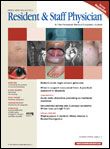Isentress (raltegravir)
Integrase inhibitors expand the HIV-1 arsenal
Merck's Isentress™ (raltegravir) is the first in a new class of antiretroviral drugs called "integrase inhibitors" to be approved by the Food and Drug Administration (FDA). These drugs work by preventing the insertion of HIV DNA into human DNA by the integrase enzyme, limiting the ability of the virus to replicate and infect new cells. Isentress tablets are approved for use in combination with other antiretroviral agents for treating HIV-1 infection in treatment-experienced adults whose infection is resistant to multiple antiretroviral agents and demonstrates evidence of viral replication.
The FDA's accelerated approval of Isentress in October 2007 was based on the 24-week results of two ongoing, mul-ticenter, double-blind, randomized, placebo-controlled Phase III studies, BENCHMRK-1 and BENCHMRK-2. These studies analyzed plasma HIV-1 RNA levels and CD4 cell counts in almost 700 treatment-experienced adults receiving Isentress in combination with optimized background therapy (OBT) or placebo plus OBT. After 24 weeks of treatment, patients receiving Isentress with OBT demonstrated significant reductions in HIV RNA viral loads and increases in CD4 cell counts compared with the group receiving placebo plus OBT.
P
P
P
P
These results were maintained after 48 weeks of treatment. Of BENCHMRK-1 patients, 170 of 231 (74%) receiving Isentress plus OBT maintained suppression of HIV RNA levels below 400 copies/mL compared with 43 of 118 (36%) receiving placebo plus OBT (< .001). In addition, Isentress plus OBT suppressed viral loads to below 50 copies/mL in 149 of 231 patients (65%) compared with 37 of 118 patients (31%) who received placebo plus OBT (< .001). CD4 cell counts also increased from baseline by 120 cells/mm3 in the Isentress cohort compared with 49 cells/mm3 for the placebo cohort (< .001). BENCHMRK-2 showed similar results after 48 weeks, with Isentress plus OBT suppressing viral loads below 400 copies/mL in 162 of 228 patients (71%) compared with 45 of 119 patients (38%) receiving placebo plus OBT; and Isentress plus OBT suppressing viral loads below 50 copies/mL in 136 of 228 patients compared with 41 of 119 (34%) patients receiving placebo plus OBT. CD4 cell counts also increased from baseline by 98 cells/mm3 in the Isentress cohort compared with 40 cells/mm3 for the placebo cohort (< .001).
The most commonly reported adverse effects regardless of drug relationship were diarrhea, nausea, headache, and fever. Creatine kinase elevations were also observed in subjects who received Isentress. Myopathy and rhabdomyolysis have been reported. Although the relationship of Isentress to these events is unclear, the drug should be used cautiously in patients at increased risk of myopathy or rhabdomyolysis, such as patients receiving concomitant medication known to cause these conditions.
The safety and efficacy of Isentress have not been established in treatment-naïve adult patients or pediatric patients. There are no study results demonstrating the effect of the drug on clinical progression of HIV-1 infection. Longer term data will be required before the FDA can consider traditional approval for Isentress.
Facts About HIV/AIDS
- In 2005, 15% of new HIV/AIDS diagnoses were in people age 50 or older.
- In 2007, approximately 33.2 million people worldwide were living with HIV infection.
- An estimated one-third of people with HIV infection are coinfected with tuberculosis.
- Approximately 25% of Americans with HIV are unaware of their infection.
- In 2005, there were an estimated 6,051 people with HIV/AIDS who had been infected perinatally.
Statistics supplied by the Centers for Disease Control and Prevention, www.cdc.gov/hiv/resources/factsheets/index.htm.
